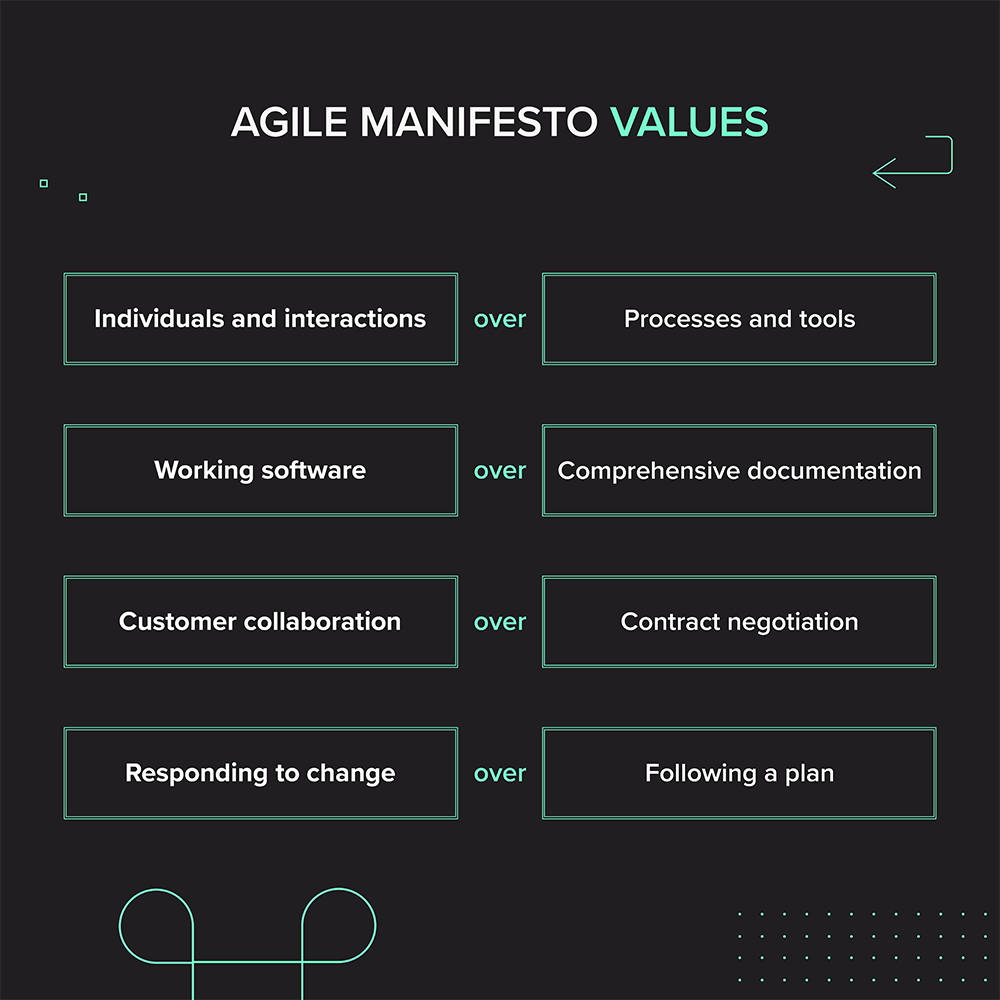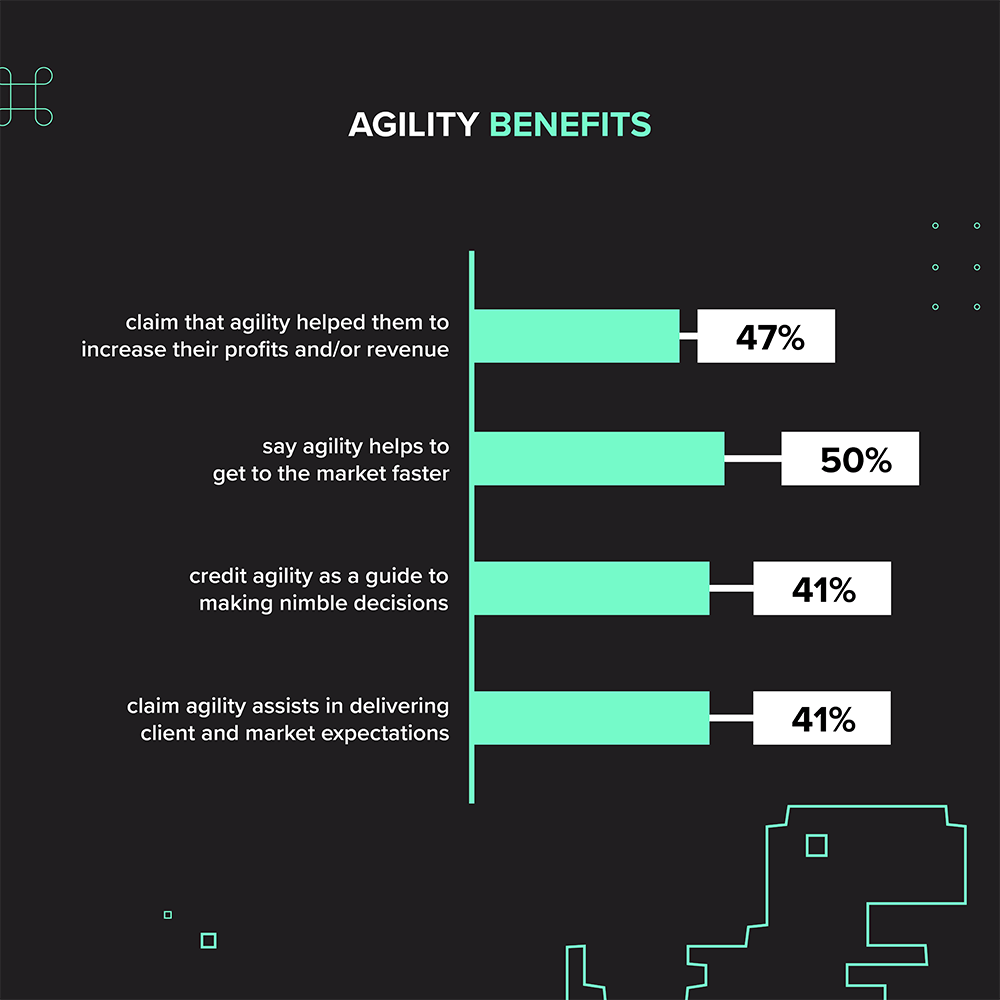What is agile and why is it best for software development
Agile (per dictionary definition „able to think quickly and clearly”) is as old as the word is, or should we rather say as the thinking human is. This article guides you through the definitions of agile and its image in everyday life, but most of all highlights how agile helps in software development to achieve the best. Because agile methodology, the right understood and used, can be a real game-changer.
Think Agile
The way we think determines our world. We all know that. How we perceive problems affects the solutions we come up with. The effectiveness of our solutions depends on how we interpret results.
And that’s what agile is – the way of thinking that affects our approach to the object we think about. Agile as a method of thinking assumes that, as reasonable creates we use our minds to meet the problem or reach the goal using the possibly best path. And if we think that something doesn’t make sense and it should not be done to reach the goal, it must be so. Agile practices trust our judgments. This is very uplifting and it’s one of the reasons the tech teams become agile teams – to have a sense of agency and to decide how they work.
Agility means also that we can acknowledge the change. Again, by using our minds we are able to evaluate the changing circumstances and the uncertainty. In other words, agile is a way of thinking about how to manage a changing reality to achieve your goal.
The beginning of agile development
The term agile development was introduced in 2001 by a group of independent thinkers representing the software development environment. They were the experts who knew the industry and the issues they struggled with. And the overarching problem was the demanding and troublesome software development process. Developers waged an endless struggle with unclear or value-lack goals, and very challenging, often unrealistic process requirements. This is why they decided to work out a new basis for the way of working in software development to „restore a balance”. Their aim was to figure out how to deliver quality working software by functioning in a supportive environment in which people are at the center.
The Agile Manifesto, which was the result of their brainstorming work, is the base of agile methodology. Its purpose is articulated clearly:
„We are uncovering better ways of developing software by doing it and helping others do it.”
Agile manifesto was welcomed by the software development teams all over the world (as it meets their needs), and agile started its journey to become the most popular methodology for software development processes.

Over the years, joint experience and verification of the agile principles gave a clear confirmation that agile works and does well for software developers and clients. This is the reason of our emphasis on educating the clients why we work in agile, and why we need our clients to follow the methodology as well.
What makes up agile software development?
Although agile might seem like a mode of action based on general, unmeasurable principles – culture, values, collaboration – the reality is otherwise. The agile development process is structured and well-defined. Of course, it’s people who are the core of the methodology, but all the tough aspects are described. Agile teams know what, how, and when. The rules are needed as they set the structure teams can rely on to deliver quality software in a supportive environment.
One of the basic principles is to work in short iterations. It means that all the phases of the process are performed in short time periods. This is done to receive feedback, as the agile development is doing well when all parties involved focus on continuous delivery. The team creates a working software and business stakeholders give feedback so that everyone knows what to improve and what to carry on with.
Phases of agile software development process

Requirements gathering
The first phase, called also the ideation is about gathering the ideas and needs – all that is important to define the project’s core. The brainstorming is aimed at establishing a project goal, defining requirements, and analyzing them in terms of their value (user stories that bring a business value).
Development teams know that at this phase, there is a lot of uncertainty. We aren’t able to know everything at the beginning, so the good collaboration between the agile team and the client is already significant. Stating the unknown and risks, but most importantly, understanding what is the goal – the need standing behind the required product and its features. The agile process is about delivering business value with a product, so the agile development teams must understand what and why the client wants to achieve with a product.
Designing
When the agile team knows, what is the goal of the software, they can start designing the product. Again, short iterations and feedback loops allow offering the client the solution that meets the requirements and brings value for users and businesses.
Coding
The worked out and agreed upon by the client design is now the base to build a product. The development phase is the longest one, and like everything, it requires regular evaluation and feedback after each iteration. The collaboration aspect plays then a major role here – coders cooperate closely with designers to put a design into a code, and the product owner keeps the client’s engagement so the team gets the regular feedback.
Testing
The way the product performs must be tested, and the eventual bugs spotted. The testing should be also conducted during the development stage, but it’s good to run some at the end of coding.
Deployment
This stage is like trying the shirt on a person it was sewing for. The team has to integrate the product with the client infrastructure and make sure everything fits well.
Review
This is the evaluation phase, understood also as maintenance. The agile team makes every effort to ensure that the product works efficiently and brings value to users, which then translates into value for the business. It’s normal that when users start to interact with the products, some unseen issues like bugs or inadequate performance can appear. At this stage, the team is focused on observing and receiving feedback, so the improvements can be implemented if needed.
Agile software development is a cycle that repeats its stages
The most important fact to be aware of is that agile practices are about continuous improvement. It doesn’t mean that we improve elements endlessly but it means that the phases of the process are intertwined. In each iteration, they can somehow happen from the beginning. It all depends on the effects provided with each iteration and the feedback received.

Agile frameworks as the way to implement agile
Many Agile advocates translate agile as a philosophy (as it relates to a way of thinking and acting) that needs proper tools to put its essence into life. Here, the agile frameworks are brought into play. They are the tools to implement the agile way of working.
There are many frameworks that agile recommends but the most popular are Scrum and Kanban. They are very important aspects of the agile methodology, as they lead the team and set the exact rules. Because agile favors self-organizing teams, the experts decide how they work, and therefore, they often mix the different frameworks. What is important is the final effect – a comfortable environment to work in, which results in the best possible software.
Both frameworks, Scrum and Kanban are based on agile methodology principles: collaboration between experts and clients, short work iterations ended with feedback loops, a supportive and innovative environment to work in, and delivery of quality software that brings value – user and business value. The frameworks are supported with the rules related to the roles, events, and practices, all of them are aimed to make the agile principles happen. Of course, both frameworks differ from each other, but their aim is the same.
Frameworks set the workflows and various practices for agile teams, which are pretty well and exactly defined. If you are interested in deepening your knowledge, or you prepare for running an agile project, be sure to read our article that explains everything you should know about Scrum and Kanban.
Benefits of agile
The best confirmation of agile benefits is the data. Forbes has published a report that describes companies’ agility performance, and the effects that companies experience as a result of agility. The data clearly confirmed the effectiveness of Agile methodologies.
All respondents claimed that introducing agile means working more effectively (and faster), and with better results. What also did the participants state?

The list of common benefits of agile is convincing and worth studying. Let’s take a look.
Producing high-quality software
Agile focuses on creating value with a product. The workflows, and practices, all of them help the development team to evaluate if there is a value in the proposed feature. After each iteration, there is a chance to examine the value. What’s even more important, is the way the requirements for the product are created. They are based on discovering business value. A significant question to answer is: why the client wants something – what effect should be achieved. This is more valuable information than the requirement itself because it often changes, but the value of the effect remains the same. Therefore, discovering the business value behind the product or its feature is essential, and agile has a great track of success in it.
Empowered development team
Sense of agency, autonomy, working on specific units instead of all the features at once… The list of perceptible benefits for the team is long, and no wonder teams like agile methods. And there is nothing new in the fact: a satisfied employee is more effective and innovative, which translates into the company’s success.
Reduced project risks
Again the agile practices, frameworks, and their elements, all take care of the project risk. Building software in short iterations enables constant evaluation of the work done and collecting feedback. Regular and transparent communication allows for spotting problems at early stages, drawing conclusions, and managing the risk effectively.

Better transparency
Continuous improvement, open discussion about the progress but also problems or risks – all of this is easier thanks to the agile frameworks. Moreover, the methodology’s core values and principles remind the team and client what is agile’s essence. Close collaboration between people, the ability to freely ask questions, and to dispute when being in doubt. These qualities create transparency helping the team stay flexible, work with changes or uncertainty, and still deliver valuable, working software.
Client satisfaction
Agile involves the client being in the process. To be part of the value the product brings. Stakeholders’ engagement is necessary, as the client knows the core – the need, the desired effect, the business environment, and users. Agile teams need clients to deliver great products. The client, in turn, has a transparent view of the whole process.
Why you should embrace agile as a client
The benefits of agile vary, and they can also be viewed from the strictly client’s perspective. Why should the client devote the time and be involved in the project, if he pays experts to do this for him?
The Standish Group’s 2020 CHAOS report estimates that around 66% of software projects fail. source
The reason for so a high percentage of failed projects is the fact that the software development process is a hard one. It’s complicated, as the technology itself is. There are many dependencies that affect the results, and there is no chance to manage them effectively without the active client’s participation. And by saying client’s participation, we don’t mean that client set the rules and knows better. We believe that a client has enough business experience to understand and trust the tested methods. The industry experts have already worked them out. Agile teams and clients’ task is to collaborate effectively to get the best possible out of these proven methods – a product that brings value to users and businesses. And this is not possible without collaboration.
Do you have needs or ideas in terms of software development? We are ready for cooperation to build for you a truly valuable product. Of course with agile as a guardian 🙂 Contact us and have a talk.
Read more about

Contact
Benefit from a free consultation
Ready to turn your software idea into reality? Collaborating with us means benefiting from our experience, expertise, and cutting-edge technology to bring your vision to life. Simply share a few words with us about your idea, and our expert will reach out to ask the ring questions.


